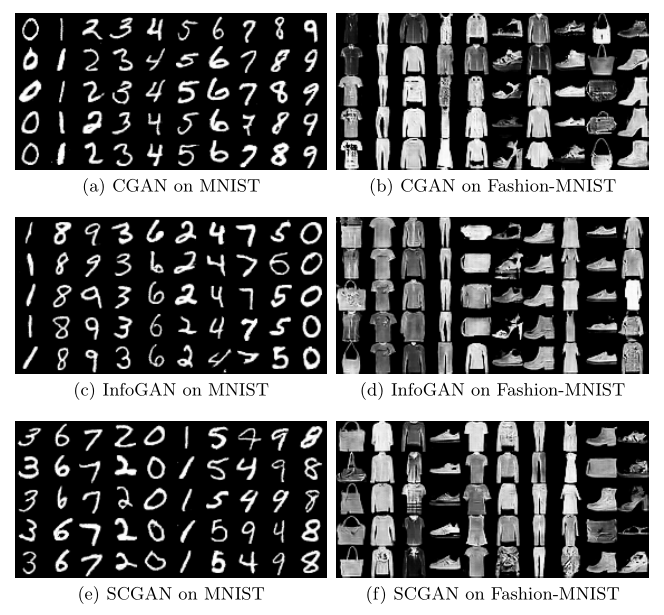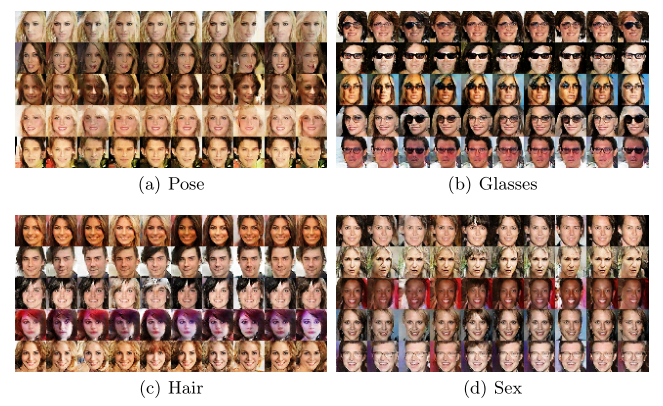Code for reproducing experiments in "SCGAN: Disentangled Representation Learning by Adding Similarity Constraint on Generative Adversarial Nets"
- Python
- Numpy
- Scipy
- Matplotlib
- Tensorflow >= 1.5
The tree of directory is listed as follow:
- DATA_DIR
- mnist
- fashion-mnist
- svhn
- cifar10
- celeba
The DATA_DIR is root directory of these datasets, you can set it any path you want, e.g. /home/username. Then you should download all datasets.
-
Download mnist dataset from MNIST, and put
train-images-idx3-ubyte.gz, train-labels-idx1-ubyte.gz, t10k-images-idx3-ubyte.gz, t10k-labels-idx1-ubyte.gzintoDATA_DIR/mnist. -
Download fashion-mnist dataset from Fashion-MNIST, and put
train-images-idx3-ubyte.gz, train-labels-idx1-ubyte.gz, t10k-images-idx3-ubyte.gz, t10k-labels-idx1-ubyte.gzintoDATA_DIR/fashion-mnist. -
Download svhn dataset from SVHN, and put
train_32x32.matintoDATA_DIR/svhn. -
Download cifar10 dataset from CIFAR, extract
cifar-10-batches-pyfromcifar-10-python.tar.gz, and putcifar-10-batches-pyintoDATA_DIR/cifar10. -
Download celeba dataset from Baidu or Google, and put
celeba_0, celeba_1, celeba_2, celeba_3(We have converted it to tfrecords) intoDATA_DIR/celeba.
python cgan_mnist.py --data_dir=DATA_DIR
python infogan_mnist.py --data_dir=DATA_DIR
python scgan_mnist.py --data_dir=DATA_DIR
It will create *.npy which contains 10000 synthetic images.
python cgan_mnist.py --train=False --data_dir=DATA_DIR
python scgan_mnist.py --train=False --data_dir=DATA_DIR
python infogan_mnist.py --train=False --data_dir=DATA_DIR
python cgan_mnist.py --dataset_type=fashion-mnist --data_dir=DATA_DIR
python infogan_mnist.py --dataset_type=fashion-mnist --data_dir=DATA_DIR
python scgan_mnist.py --dataset_type=fashion-mnist --data_dir=DATA_DIR
It will create *.npy which contains 10000 synthetic images.
python cgan_mnist.py --train=False --dataset_type=fashion-mnist --data_dir=DATA_DIR
python infogan_mnist.py --train=False --dataset_type=fashion-mnist --data_dir=DATA_DIR
python scgan_mnist.py --train=False --dataset_type=fashion-mnist --data_dir=DATA_DIR
On MNIST and Fashion-MNIST, we find categorical conditional variables capture class labels, e.g., digit type, clothing type.
We use gaussian parzen window to estimate log-likelihood on 10000 synthetic images for each model.
python gaussian_parzen_window.py --data_dir DATA_DIR/mnist --gen_data_path result/cgan_mnist/cgan_mnist.npy --file result/cgan_mnist/cgan_mnist.txt
python gaussian_parzen_window.py --data_dir DATA_DIR/mnist --gen_data_path result/scgan_mnist/scgan_mnist.npy --file result/scgan_mnist/scgan_mnist.txt
python gaussian_parzen_window.py --data_dir DATA_DIR/mnist --gen_data_path result/infogan_mnist/infogan_mnist.npy --file result/infogan_mnist/infogan_mnist.txt
python gaussian_parzen_window.py --data_dir DATA_DIR/fashion-mnist --gen_data_path result/cgan_fashion-mnist/cgan_fashion-mnist.npy --file result/cgan_fashion-mnist/cgan_fashion-mnist.txt
python gaussian_parzen_window.py --data_dir DATA_DIR/fashion-mnist --gen_data_path result/scgan_fashion-mnist/scgan_fashion-mnist.npy --file result/scgan_fashion-mnist/scgan_fashion-mnist.txt
python gaussian_parzen_window.py --data_dir DATA_DIR/fashion-mnist --gen_data_path result/infogan_fashion-mnist/infogan_fashion-mnist.npy --file result/infogan_fashion-mnist/infogan_fashion-mnist.txt
Gaussian Parzen window-based log-likelihood estimates for MNIST and Fashion-MNIST.
| Model | MNIST | Fashion-MNIST |
|---|---|---|
| CGAN | 228.1 ± 2.2 | 312.7 ± 2 |
| InfoGAN | 231 ± 2.2 | 320.2 ± 2 |
| SCGAN | 233.6 ± 2.2 | 321.7 ± 2 |
python scgan_svhn.py --data_dir=DATA_DIR
Fix one conditional variable, and vary the other conditional variable.
python scgan_svhn.py --train=False --data_dir=DATA_DIR --con_dim=0
python scgan_svhn.py --train=False --data_dir=DATA_DIR --con_dim=1
We select some good-quality synthetic images. Continuous variables capture variation on lighting and digit types.
python scgan_cifar.py --data_dir=DATA_DIR
Fix one conditional variable, and vary the other conditional variable.
python scgan_cifar.py --train=False --data_dir=DATA_DIR --con_dim=0
python scgan_cifar.py --train=False --data_dir=DATA_DIR --con_dim=1
We select some good-quality synthetic images. Continuous variables capture variation on object size and colour.
python scgan_celeba.py --data_dir=DATA_DIR
Fix three conditional variables, and vary the remaining conditional variable.
python scgan_celeba.py --train=False --data_dir=DATA_DIR --con_dim=0
python scgan_celeba.py --train=False --data_dir=DATA_DIR --con_dim=1
python scgan_celeba.py --train=False --data_dir=DATA_DIR --con_dim=2
python scgan_celeba.py --train=False --data_dir=DATA_DIR --con_dim=3
We select some good-quality synthetic images. Categorical variables capture variation on pose, glasses, hair and sex.
Note: There is no guarantee that one conditional variable just captures a kind of representation, so that InfoGAN uses ten 10-dimensional categorical variables to capture these representations.
If you use SCGAN in your research, we would appreciate references to the following paper:
Biblatex entry:
@article{li2018scgan,
title={SCGAN: Disentangled Representation Learning by Adding Similarity Constraint on Generative Adversarial Nets},
author={Li, Xiaoqiang and Chen, Liangbo and Wang, Lu and Wu, Pin and Tong, Weiqin},
journal={IEEE Access},
volume={7},
pages={147928--147938},
year={2018},
publisher={IEEE}
}



